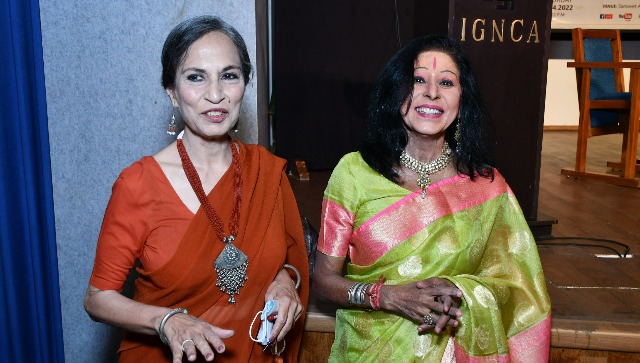Kathak Guru and Padma Shri recipient Shovana Narayan along with Geetika Kalha unveiled their new book titled “Kathak Lok: Temples, Traditions and History” recently. This deeply researched book, which has been published in both English and Hindi along with its DVD format, is the result of 7,000 kilometres of travel through North India by the authors and five years of fieldwork, investigation, and research. The mission was to understand the existence of Kathak villages and what ‘Kathak Lok’ represented. Geetika says that they made about three to four trips to Uttar Pradesh and Bihar visiting over a dozen villages, where they learnt of the Brahmin Kathak Lok (community). “When we met the Kathak Lok and heard of their original role in society and their history, it motivated us to write this book. We made four trips to Rajasthan but found that there were no Kathak villages there. In total we drove 7000 km,” said Geetika Kalha. There were challenges too while doing the research but they won’t call them hardships. “Speaking of challenges, my first challenge was in 2003 when I started looking for a village called Kathak Gaon (Kathak Gram) for it was like looking for a needle in a haystack. Then other challenges included verifying the veracity of statements made by people, searching for primary, original sources in terms of archival records, shastras, ancient texts, ancient references, and cross-checking everything that we were told,” said Shovana Narayan, who has performed in India and internationally, and has been trained under late Birju Maharaj .
The authors first heard about Kathak villages in Bodh Gaya (in 2003) when a journalist asked to visit the Kathak villages. “In spite of finding three Kathak villages after a hectic search, taking photographs of all corollaries such as school signboards that displayed the name of the Kathak village, only a handful of people in the wide urban world believed it. More than a decade later going through the Census of India, I realized that there were many more Kathak villages. I became determined to visit them and find out more about them and if and how they were related to Kathak dance. “I then asked Geetika Kalha to join me in this venture. This was the beginning of our journey towards the roots of Kathak Lok and Kathak villages,” said Shovana. Going from village to village, seeing Kathak Lok dance in temples, meeting Maharajas, dancers, scholars, and swamis, the authors, Shovana Narayan and Geetika Kalha, peeled layer upon layer of history. The authors unearth little-known facts of pre-Christian era roots of Kathak and its role in propagating and preserving dharma, over the centuries, which continue as a living tradition today. Shovana and Geetika say that after meeting the Kathak Lok and learning about their history, they felt that Kathak has been misrepresented and misunderstood in the country relating to its origin, its development, its practitioners, and locale of practice. “We found that popular narratives were totally at variance with ground realities – realities that had inscriptions, sculptures, archival records et al staring in our faces – yet somehow they have been buried under a barrage of misinformation and disinformation,” said Shovana. This book shatters many popular perceptions such as the Mughal origins of Kathak. “The most common belief is that Kathak is a Moghul Court dance and that it is a Persian dance or heavily influenced by Persian dance. Till date, however, no one has done a comparative study of Kathak and any Persian dance and there is no evidence of Kathak Lok dancing in a Moghul court,” said the acclaimed Kathak dancer. Further, there are several theories about the origin of Kathak dance, such as Vrindavan Raas Leela gave birth to Kathak, or the Kathak Lok were originally Bhands, and many more. However, all these were totally negated when the writers researched each one. “Another myth is that Kathak is not Shastra based (Natyashastra and Abhinaya Darpan etc) which again is far off the mark. There are too many such misconceptions that I can mention here and hence each one must read the book as every word and statement has been backed up by ancient references and archival records,” insists Shovana Narayan. The DVD of the book, directed by Beenu Rajpoot, encapsulates interviews with members of the Kathak Lok and with patrons, providing a glimpse into the Kathak villages, archival records, and the living temple dance tradition of the Kathak Lok and the journey of the authors. Talking about how prominent is Kathak as a dance form in today’s time, the writers believe that classical, traditional, and popular arts have always co-existed in all cultures of all ages. “As regards our Bharatvarsh, the importance of classical arts can be seen in its reflection in imageries of our deities as classical artistes. Thus, classical dance in Bharat has an important place in our culture,” said Shovana. She also agrees that the youth today are taking to classical dances in a big way. “While popular media may be more heavily slanted towards the promotion of popular culture, yet on the ground, we find that the number of members of the young generation is passionately pursuing the study of classical arts, with several aiming to take it as their full-time vocation. This is despite the overarching visibility of the movie industry, which goes to show co-existence of all genres for each has its own place,” she said. With this book, both Shovana and Geetika, want people to learn the truth about Kathak, which is an important ancient cultural practice of North India. Read all the **_Latest News_** _,_ **_Trending News_** _,_ **_Cricket News_** _,_ **_Bollywood News_** _,_ **_India News_** and **_Entertainment News_** here. Follow us on Facebook_,_ Twitter and Instagram_._


)
)
)
)
)
)
)
)
)



